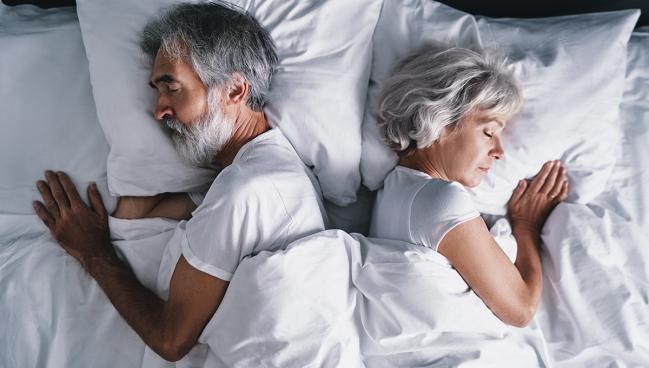Constellations of Sleep Issues Can Point to Patients at Risk for AF
Hypoxia signaled the highest risk, though other phenotypes also mattered, raising a potential new tool for risk stratification.

Patients with certain clusters of sleep-related symptoms and polysomnography (PSG) measures are at an increased risk for developing atrial fibrillation (AF), registry data show.
The greatest risk (HR 1.48) over roughly 8 years of follow-up was seen for patients with the hypoxia phenotype, characterized by the lowest oxygen saturation and the highest percentage of sleep time spent with an oxygen saturation below 90%, although other subtypes carried risk as well, researchers led by Catherine Heinzinger, DO (Cleveland Clinic, OH), report in a study published online this week in JACC: Clinical Electrophysiology.
They found that the symptom of sleepiness and features of sleep architecture like the duration of sleep and the proportion of rapid eye movement (REM) sleep may be associated with the development of AF and that apneas (complete or near cessation of breathing) appeared to be stronger drivers of new-onset AF than were hypopneas (reflective of shallower breathing).
“This lays the groundwork for us to consider how these different cluster-based phenotypes may help us in stratifying risk,” senior author Reena Mehra, MD (University of Washington, Seattle), told TCTMD. “So if we see a greater degree of hypoxia, we know then that those folks may be at greater risk for developing atrial fibrillation over time.”
In addition to potentially improving clinical pathways around diagnosis and management, the findings also provide a basis for future studies evaluating whether intervening on hypoxia in particular with treatments like continuous positive airway pressure, medications, and nocturnal supplemental oxygen can improve patient outcomes, Mehra said. “I think it sets the stage to inform the design of these interventional studies that can help us parse this out a bit more.”
Sleep-disordered breathing, like obstructive sleep apnea, has been shown to be a significant risk factor for AF, with purported mechanisms related to inflammation, oxidative stress, changes in intrathoracic pressure, and atrial remodeling, according to the authors.
Prior studies have examined how clusters of sleep symptoms and PSG measures are related to risks of CVD and mortality, but these types of analyses were not conducted to specifically look at AF, Mehra said.
“Characterizing distinct sleep profiles that differ in incident AF can provide valuable insights into the role of sleep disturbance in AF pathogenesis, contribute to precision medicine via personalized risk stratification, and identify high-risk subgroups to inform targeted interventions for AF prevention,” the researchers write.
To explore this issue, they turned to the STARLIT registry of patients who underwent sleep studies at the Cleveland Clinic between November 27, 2004, and December 30, 2015. There were 43,433 individuals (mean age 52; 48% women) included in the cluster analysis. Exclusion of the 7.3% who had AF at baseline left 40,214 who were followed for a median of 7.6 years; 8.9% developed new-onset AF over that span.
The investigators identified five distinct phenotypes based on 23 sleep symptoms, the Epworth Sleepiness Scale score, and 24 PSG-based measures of sleep-disordered breathing and sleep architecture.
- Long sleep and REM subtype (62% of patients): the longest sleep time, the shortest time to reach REM, and the highest proportion of REM
- Short sleep and non-REM subtype (14% of patients): the shortest sleep time, the longest time to reach REM, and the lowest proportion of REM
- Apneas and arousals subtype (11% of patients): the highest prevalence of witnessed apneas, the highest apnea-hypopnea index, the fewest hypopneas, and the greatest frequency of arousals during sleep
- Hypoxia subtype (8% of patients): the lowest oxygen saturation and the highest percentage of sleep time spent with an oxygen saturation below 90%
- Hypopneas subtype (6% of patients): the most hypopneas
Compared with the long sleep and REM subtype, the greatest risk of new-onset AF was seen for patients with the hypoxia phenotype (HR 1.48; 95% CI 1.34-1.64), with significantly increased risks also observed for the apneas and arousals subtype (HR 1.22; 95% CI 1.10-1.35) and the short sleep and non-REM subtype (HR 1.11; 95% CI 1.01-1.22). No difference in AF risk was seen for the hypopneas subtype (HR 0.89; 95% CI 0.77-1.03).
“Consistent with prior evidence supporting hypoxia as an AF driver and cardiac risk of the sleepy phenotype, this constellation of symptoms and physiologic alterations illustrates vulnerability for AF development, providing potential value in enhancing our understanding of integrated sleep-specific symptoms and physiologic risk of atrial arrhythmogenesis,” the investigators write.
Looking ahead, they highlight the need for future studies examining different outcomes and additional sleep-related predictors, which will allow for a deeper understanding of potential mechanisms linking sleep and AF.
In the meantime, “patients with sleep-related hypoxia should be made aware that they are vulnerable to developing AF and screening for sleep-disordered breathing can be considered,” they advise. “It is important to discuss sleep-related symptoms with patients, as this may help determine cardiac risk.”
Todd Neale is the Associate News Editor for TCTMD and a Senior Medical Journalist. He got his start in journalism at …
Read Full BioSources
Heinzinger CM, Lapin B, Thompson NR, et al. Novel sleep phenotypic profiles associated with incident atrial fibrillation in a large clinical cohort. JACC Clin Electrophysiol. 2024;Epub ahead of print.
Disclosures
- The study was supported by a Transformative Neuroscience Research Resource Development Award funded by the Cleveland Clinic Foundation; a Neurological Institute Center for Outcomes Research and Evaluation Pilot Grant funded by the Cleveland Clinic Foundation; SMARRT (Supporting Multidisciplinary Achievement in Respiratory Research Training) grant T32HL155005 funded by the National Heart, Lung, and Blood Institute of the National Institutes of Health; and Physician Scientist Training Grant 302-PA-23 funded by the American Academy of Sleep Medicine Foundation.
- Heinzinger and Mehra report no relevant conflicts of interest.





Comments